
* The Falcon AAM became a mainstay of the US Air Force through the 1960s, and was exported in some numbers; it did not see much combat action. The Sidewinder equipped effectively all US fighter aircraft, and still does today. The Sidewinder became a standard for Western air forces, and has seen plenty of combat action. The long-range Phoenix AAM was only used on the US Navy Grumman F-14 Tomcat, and was never fired in anger by the Navy -- though the Iranians, who acquired the Tomcat, did use it against the Iraqis in the 1980s.
* From 1943, the US Navy had worked on a bewildering range of experimental missiles under the general name of "Gorgon", with some versions intended as air-to-air missiles (AAM). Gorgon never amounted to much as a study exercise for later developments. From 1944, the US Army Air Forces (USAAF) worked with Hughes under Project "MX-570" to develop the big "JB-3" AAM -- but though it was test-flown from 1945, it proved unsatisfactory, and was canceled the next year.
By that time, both the Navy and USAAF were becoming more earnest about AAM research. In 1946, the USAAF awarded study contracts to several weapons manufacturers to investigate AAM technology. The Ryan Aeronautical company was assigned a project designated "MX-799", with a contract awarded to the firm in 1947 to develop the "AAM-A-1 Firebird". First launch of an "XAAM-A-1" was in prototype in October 1947, by which time the USAAF had become a separate service, the US Air Force (USAF).
The Firebird was a cigar-shaped missile, with swept wings in an "X" configuration at midbody, and swept tailfins in a cruciform configuration on the tail. The wings pivoted for flight control; the tailfins were fixed. The missile had a "boost / sustain" rocket motor system, with a solid-fuel booster providing initial velocity, with a liquid-fuel sustainer then taking over. The missile had a length of 2.29 meters (7 feet 6 inches), a diameter of 20 centimeters (8 inches), a wingspan of 81 centimeters (32 inches), and a launch weight of 120 kilograms (260 pounds) -- including a 41-kilogram (90-pound) warhead.
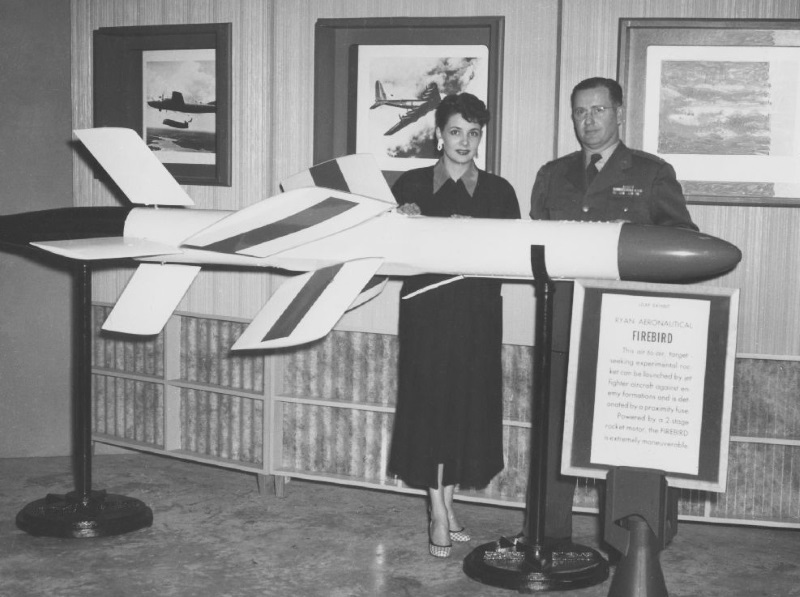
The Firebird was "command-guided", meaning it was radio-guided to the target, with an operator providing guidance corrections; the missile had a radar seeker for terminal attack on the target. Sources are mixed on whether the seeker used "semi-active radar homing (SARH)" -- that is, it only carried a radar receiver and homed in on reflections of the radar beam emitted by the launch aircraft -- or it had a fully active radar seeker, with both transmitter and receiver. It had a proximity fuze and backup impact fuze for warhead detonation.
In trials, the Firebird was launched by Douglas DB-26 Invader and North American P-82 Twin Mustang aircraft. Trials went well, though the command guidance scheme was clearly unsatisfactory; not only was it difficult to use, it also limited the weapon's use to clear daylight weather. Work was done to develop a "beam-riding" scheme as a replacement, in which the missile would use a receiver in the tail to fly in the center of a radar beam emitted by the launch aircraft. However, the Firebird was a subsonic missile, and by late in the 1940s, it was clear that supersonic combat aircraft were the way of the future; the Firebird program was canceled. It was not seen as a wasted effort, since it laid the groundwork for better AAMs to follow.
* The first US guided AAM to actually reach operational service was the Hughes "Falcon", which began as a 1946 study conducted by Hughes for the USAAF focusing on a subsonic guided AAM designated "MX-798". This effort evolved to a 1947 study designated "MX-904" for a supersonic guided AAM intended to be launched from bombers for self-defense, with the AAM itself given the designation of "AAM-A-2".
Initial test firings of the AAM-A-2 were performed in 1949. The next year, 1950, the program's goals were modified again, to develop a guided AAM for use by interceptors against bombers, with the weapon assigned the name of "Falcon". The year after that, 1951, the USAF began to assign aircraft-type designations to missiles, with AAMs acquiring "F" for "fighter" designations: the AAM-A-2 became the "F-98", with test firings continuing of "XF-98" prototypes and then "YF-98" preproduction rounds.
The first production F-98 was rolled out in 1954. In 1955, the Air Force decided to change the designation scheme for missiles again to "Guided Aircraft Rocket (GAR)", and the F-98 became the "GAR-1". The GAR-1 went into service with Northrop F-89H/J Scorpion and Convair F-102A Delta Dagger interceptors in 1956, with about 4,000 GAR-1s produced. Falcons would also be carried on the McDonnell F-101B and Convair F-106s interceptors, the F-106 being the much-improved successor to the F-102. Other US fighter jets would carry the Falcon on occasion, but not as a standard weapon.
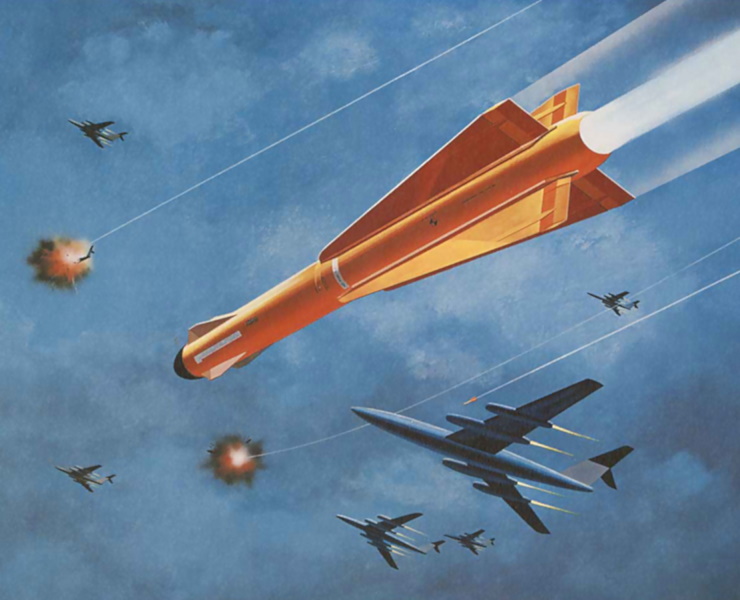
Although early experimental missiles in the series had featured wings in the midbody in an "X" configuration and cruciform tailfins, the GAR-1 featured small fixed cruciform nose fins and long cruciform delta wings, with control surfaces in the rear. The missile used SARH guidance, was powered by a Thiokol solid-fuel rocket motor, and had a small 3.4-kilogram (7.6-pound) warhead. The warhead had an impact fuze; a proximity fuze was not used, because the bombers the GAR-1 was intended to be used against were seen as easy targets.
___________________________________________________________________
GAR-1 (AIM-4) FALCON AAM:
___________________________________________________________________
wingspan:
51 centimeters (20 inches)
length:
2.0 meters (6 feet 6 inches)
diameter:
16 centimeters (6.4 inches)
total weight:
58 kilograms (127 pounds)
warhead weight:
3.6 kilograms (8 pounds)
speed:
Mach 3
range:
8 kilometers (5 MI / 4.35 NMI)
___________________________________________________________________
Work was performed roughly in parallel on a variant of the GAR-1 with infrared heat-seeking guidance, resulting in the "GAR-2" -- originally designated the "GAR-1B" -- which was also introduced in 1956. The "spin-scan" seeker system was based on a patterned disk spinning in front of a light sensor. The pattern varied in an elaborate fashion that chopped up the image obtained by the sensor, the output driving an analog control system that adjusted the missile's control surfaces to bring a heat source into the line of sight. Aside from the seeker, the GAR-2 was generally identical to the GAR-1.
The GAR-2 was followed by the "GAR-2A", which had an improved seeker; it was slightly longer and heavier than the GAR-2. Usually an interceptor carried both SARH and heat-seeking Falcons to ensure higher kill probability. About 26,000 GAR-2/2A AAMs were built in all.
The SARH GAR-1 was followed by the improved SARH "GAR-1D", which featured higher performance, and noticeably the wings moved forward -- leaving the control surfaces spaced behind the wings, permitting greater agility. The GAR-1D was the main production version of the original SARH Falcon, with about 12,000 rounds built. There was some thought of producing a version of the GAR-1D with heat-seeking guidance, but development of a second generation of Falcons meant that didn't happen.
BACK_TO_TOP* The second-generation Falcon was introduced in 1958 as the "GAR-3 Super Falcon", though the "Super" label didn't stick. It was a SARH weapon, featuring a slightly larger airframe, plus an improved solid-rocket motor for more range. The delta wings were fitted with distinctive forward strakes; the warhead was increased in size.
Only about 300 GAR-3s were made, with the weapon quickly being upgraded to the "GAR-3A", with an improved SARH seeker -- featuring greater accuracy and better resistance to countermeasures -- plus a further improved solid-rocket motor. About 3,400 GAR-3As were built, with the new AAM generally replacing the GAR-1D in service.
___________________________________________________________________
GAR-3A (AIM-4F) FALCON AAM:
___________________________________________________________________
wingspan:
61 centimeters (24 inches)
length:
2.2 meters (7 feet 2 inches)
diameter:
16.8 centimeters (6.6 inches)
total weight:
69 kilograms (152 pounds)
warhead weight:
3.9 kilograms (8.65 pounds)
speed:
Mach 4
range:
10.6 kilometers (6.6 MI / 5.7 NMI)
___________________________________________________________________
The second-generation heat-seeking Falcon finally emerged as the "GAR-4A", essentially the same as the GAR-3A but with an infrared seeker, with greater sensitivity than the GAR-2/2A, which the GAR-4A replaced in service. The GAR-4A went into service in 1959, with about 2,700 rounds built. The GAR-3A and GAR-4A became the standard armament for the Convair F-106 Delta Dart interceptor, the improved follow-on to the F-102 Delta Dagger.

The Swedes license-built a hybrid of the GAR-2A airframe with the GAR-4A seeker as the "Robot 28 (Rb 28)" -- the "Robot" being short for "JaktRobot (Hunting Robot)", an amusingly theatrical name for a guided missile -- with the missile carried by the SAAB Draken fighter. The Rb 28 was built by a consortium of Bofors, SAAB, and Ericsson, presumably for the warhead, airframe, and guidance system respectively. The missile was tweaked in a number of ways, and said to have been the best of the Falcons.
In 1962, the US military adopted a multiservice designation scheme, with the Falcon designations being changed once again:
When the name change went into effect, work was being performed on the "GAR-2B". It was something of a hybrid, with the first-generation airframe of the GAR-2A and the improved heat seeker of the GAR-4A. It went into service in 1963 as the "AIM-4D", with about 4,000 rounds produced. Many GAR-1D/2A rounds were updated to the AIM-4D standard.
The AIM-4D was used for a relatively brief time by USAF McDonnell F-4 Phantoms and Convair F-102s in the Vietnam War, but it did not prove satisfactory. One problem was that the seeker had to be chilled by cooling gas for about five seconds before firing. An infrared sensor can't pick up a target that is cooler than it is, so cooling the sensor improves sensitivity; a can of carbon-dioxide gas leaking through a pinhole provided the cooling.
The cooling requirement wasn't such a problem for sneaking up on a bomber and blowing it out of the sky, but troublesome when the target was a fast-moving enemy fighter. Once the cooling gas was depleted, which didn't take many false alarms, the Falcon was so much dead weight, and had to be hauled back to base. Had it been used as a long-range BVR weapon, it would have been much more effective, but the "rules of engagement" at the time demanded visual identification of a target before launch.

There was work on an "XAIM-4H", with a handful produced in 1970:1971; it was an enhanced AIM-4D with better maneuverability, an improved warhead, and a laser-based proximity fuze. However, better AAMs were available by then, and no further need was seen for the obsolescent AIM-4. The AIM-4D was phased out of USAF service from 1969, with the last of them withdrawn by 1973. The AIM-4F/G remained in service on the F-106 Delta Dart into the 1980s, until the F-106s were pulled out of service during that decade.
BACK_TO_TOP* American interceptors like the F-106 carried another missile along with their Falcons, the Douglas "AIR-2 Genie". It had no particular technical relationship to the Falcon; it was just that interceptors like the F-89, F-101, F-102, and F-106 often carried both of them.
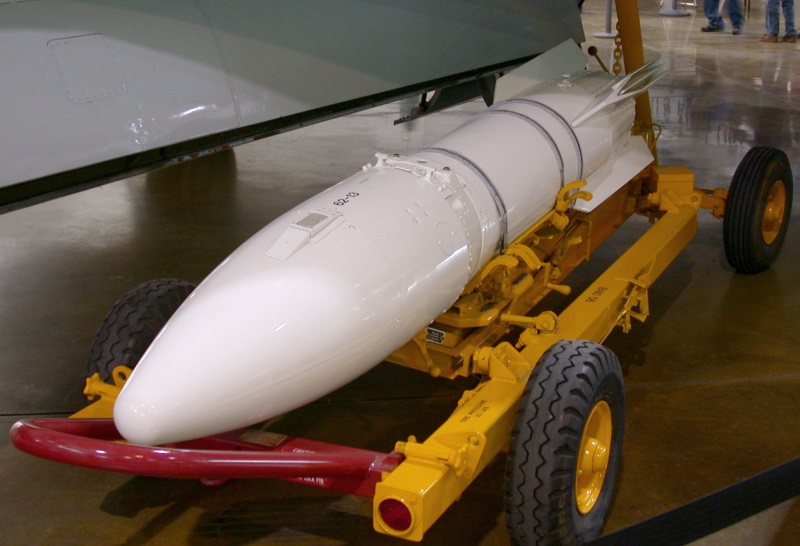
Douglas began work on the Genie in 1954, with the weapon entering service in 1957, originally as the "MB-1". The Genie was a solid-fuel unguided rocket, with four pop-out tailfins; it carried a W25 nuclear warhead, with a yield of about 1.5 kilotons. The Genies had a detonation timer that started after engine burn-out; lethal radius was about 300 meters (1,000 feet). It was intended for "collision-course" intercepts, the interceptor crossing the path of the target, instead of chasing it from the tail; the interceptor's fire-control system computer the optimum trajectory to the target, with the nuclear warhead eliminating the need for a guidance system.
___________________________________________________________________
AIR-2 GENIE:
___________________________________________________________________
wingspan:
61 centimeters (24 inches)
length:
2.2 meters (7 feet 2 inches)
diameter:
16.8 centimeters (6.6 inches)
total weight:
373 kilograms (822 pounds)
warhead weight:
3.9 kilograms (8.65 pounds)
speed:
Mach 3.3
range:
10 kilometers (6 MI / 5.7 NMI)
___________________________________________________________________
There was a single live test of the Genie, performed in 1957, the rocket being fired by an F-89 Scorpion. The missile was nicknamed "Ding-Dong", clearly for its phallic shape. It was redesignated "AIR-2A" in 1962. About 3,150 were built up to end of production in 1963. Most were later upgraded to a new solid-rocket motor, these weapons being informally designated "AIR-2B". There was also an inert training round, originally the "MB-1-T", from 1962 the "ATR-2A".
The only foreign user of the Genie was Canada, which carried the thing under a "dual-key" US-Canadian arrangement. The Genie was never fired in anger, which was just as well; it was finally retired in 1988, along with the F-106. It was always troublesome to handle a nuclear store, and it appears at least some aircrew were scared of a Genie -- no doubt partially because of the discomfort of being anywhere near a nuclear weapon, also because an occasion for its use could mean the end of civilization.
* The unguided Genie was complemented by a guided nuclear Falcon, originally designated the "GAR-11". Work on the missile was initiated in 1959, following up an earlier development effort that had been canceled, with the weapon originally designated the "GAR-11". The idea was, more or less, to add the killing power of the Genie to a guided weapon, to ensure more reliable collision-course intercepts.
The GAR-11 had the same general flight surface arrangement of the other Falcons, but it was plumper in appearance. It was fitted with a W54 nuclear warhead, with a yield of about a kiloton, and featured a proximity fuze. It used SARH homing, since the heat-seekers of the era were only useful for traditional tail-chase intercepts.
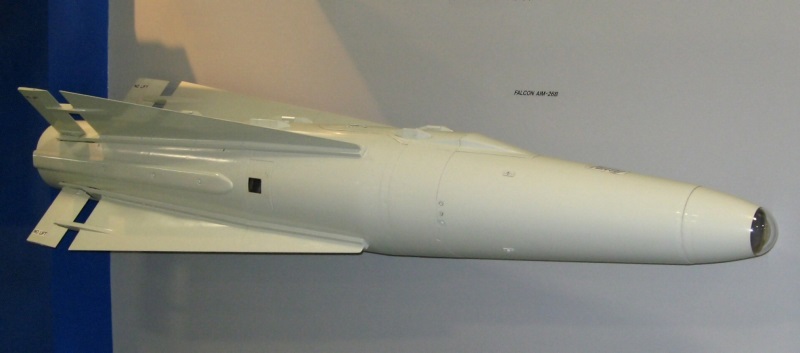
The W54 could not be used against a low-flying target, and so development work was performed on a "GAR-11A" with a large conventional warhead in parallel. In 1962, the GAR-11 became the "AIM-26A" and the GAR-11A became the "AIM-26B". About 4,000 AIM-26A/B AAMs were built in all, with the USAF mostly using the AIM-26A.
___________________________________________________________________
AIM-26A FALCON:
___________________________________________________________________
wingspan:
62 centimeters (24 inches)
length:
2.14 meters (7 feet)
diameter:
28 centimeters (11 inches)
total weight:
82 kilograms (203 pounds)
speed:
Mach 2
range:
16 kilometers (10 MI / 8.7 NMI)
___________________________________________________________________
Improvements in the AIM-7 Sparrow AAM rendered the AIM-26 series obsolete, and it was phased out of service in 1971. The Swedes license-built the AIM-26B as the "Robot 27 (Rb 27)", which was also carried on the Draken fighter.
BACK_TO_TOP* Hughes worked on a rethought derivative of the Falcon, originally designated the "GAR-9". It was to arm the "LR-X" advanced interceptor, which emerged as the North American "XF-108 Rapier", following award of a contract in the spring of 1958. Hughes was awarded a contract for the GAR-9, and the Rapier's AN/ASG-18 fire-control system in parallel. Range of the missile was to be up to 40 kilometers (25 miles); it was to have either a conventional or nuclear warhead.
During development, range was extended to 160 kilometers (100 miles). Since SARH guidance couldn't work at that range, the requirement was changed to a fully-active radar seeker. With an accurate seeker, the troublesome nuclear warhead was dropped. A 45-kilogram (100-pound) conventional warhead would be used instead.
Although the Rapier was canceled in the fall of 1959, the Air Force didn't cancel the GAR-9 program, seeing that a long-range AAM would be a nice thing to have. As a replacement for the Rapier, from 1960 the Air Force worked on the "F-12", an interceptor derivative of the Lockheed A-12 spyplane, which evolved into the famous SR-71 Blackbird. The F-12 would use the GAR-9 and AN/ASG-18.
___________________________________________________________________
HUGHES AIM-47:
___________________________________________________________________
wingspan:
84 centimeters (33 inches)
length:
3.82 meters (12 feet 6 inches)
diameter:
34 centimeters (14 inches)
total weight:
371 kilograms (818 pounds)
speed:
Mach 4
range:
> 160 kilometers (> 100 MI / 85 NMI)
___________________________________________________________________
There was some consideration of liquid-rocket propulsion, but the design had settled on a solid-rocket engine by the time ground test firings began in the summer of 1961. For flight tests, a Convair B-58 Hustler Mach 2 bomber was fitted with the AN/ASG-18 radar -- in an extended nose, this machine being called "Snoopy" after the well-known cartoon beagle -- with launches beginning in the spring of 1962. Later in that year, the missile was redesignated "AIM-47".
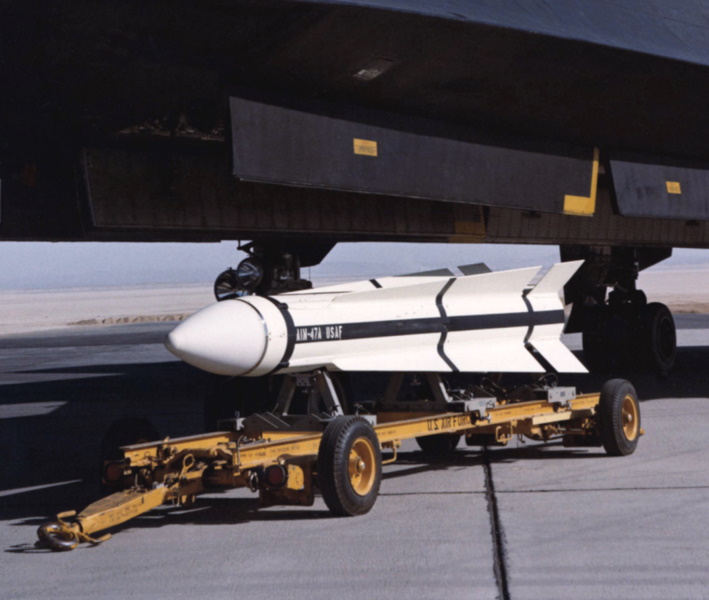
The first of three "YF-12A" prototypes performed its initial flight in the summer of 1963. The YF-12A could carry three AIM-47s in internal weapons bays; the AIM-47 had folding fins to allow it to fit. The three YF-12As performed test firings -- including seven guided launches, with six kills. Funding for the YF-12A was put on ice in 1965, with the program formally canceled in 1968. There had been consideration of a compact or "compressed-carriage" variant, the "AIM-47B", but it never happened.
The end of the F-12 meant the end of the AIM-47, about 80 pre-production missiles having been produced to that time. The AIM-47 was used as the basis of "AGM-76" heavyweight anti-radar missile (ARM), the AIM-47 airframe being fitted with a radar seeker derived from that of the AGM-45 Shrike missile -- itself a modification of the AIM-12 Sparrow AAM -- and a heftier 110-kilogram (250-pound) warhead, based on the Mark 81 "dumb" bomb. A number of AGM-76 missiles were built, but the requirement was fulfilled by the "AGM-78", an ARM version of the US Navy's Standard surface-to-air missile.
* The AIM-47 wasn't really a dead end, however. In the late 1950s, the US Navy had worked on a "fleet defense" interceptor, the Douglas "F6D Missileer" -- a subsonic design with a long loiter endurance, looking much like a scaled-up version of the Douglas F3D Skyknight, a carrier-based all-weather interceptor that fought in the Korean War. The stodgy-looking Missileer wasn't a dogfighter, it was instead a "flying missile launcher", to carry six Bendix "AAM-N-10 Eagle" long-range AAMs.
The Eagle was to be a two-stage missile, with a booster and a cruise stage, with a total length of 4.92 meters (16 feet 2 inches) and a range of up to 300 kilometers (185 miles). It would be radio-guided during midcourse flight, using an active radar seeker for terminal attack. There were second thoughts about using a slow "missile truck" for fleet defense, and so the Missileer was canceled in late 1960.
The Navy requirement remained open, however. In 1962, the Air Force initiated a development program for the "F-111" strike fighter; in the interests of commonality, the Defense Department also ordered the development of a fleet interceptor based on the F-111, designated the "F-111B". It was to be armed with the "AAM-N-11" long-range AAM, which would emerge as the "AIM-54 Phoenix", with Hughes getting the contract.
The Phoenix program owed much to the GAR-9 and Eagle. The AIM-54 was to have SARH guidance for cruise, active radar guidance for terminal attack, and long range of over 160 kilometers (100 miles) to provide fleet defense against aircraft and cruise missiles. Initial launch tests were in 1965, with the first "all-up" shot taking place on 8 September 1966, a Douglas A-3A Skywarrior doing the honors.

The Navy was never enthusiastic about the F-111B; it was just too big. It was canceled in 1968, with the Navy immediately moving on to the fleet interceptor they really wanted, the Grumman "F-14 Tomcat". The Tomcat and the Phoenix were complementary weapons, with the fighter able to carry six of the missiles and fire all of them at separate targets simultaneously, using the aircraft's powerful AN/AWG-9 radar and sophisticated fire-control system.
This capability was demonstrated in an exercise on 21 November 1973, with six missiles launched, scoring four kills, an unprecedented achievement. It was not a cheap trial, one person involved in it comparing it to destroying a parking garage full of new Cadillacs. The Phoenix entered US Navy service the same year, 1973.
___________________________________________________________________
AIM-54C PHOENIX:
___________________________________________________________________
wingspan:
91 centimeters (3 feet)
length:
4.0 meters (13 feet)
diameter:
38 centimeters (15 inches)
total weight:
450 kilograms (1,000 pounds)
warhead weight:
61 kilograms (135 pounds)
speed:
> 4,680 KPH (> 3,000 MPH / 2,610 KT)
range at altitude:
> 160 kilometers (> 100 MI / 85 NMI)
___________________________________________________________________
The original AIM-54A was followed by the AIM-54C, with a more powerful motor and improved avionics systems. The AIM-54C went into service in 1981 and entered full-rate production in early 1984. The Phoenix was finally phased out of service in late 2004, as the Tomcat was being retired. From the late 1980s, there was work on a replacement for the Phoenix, to be designated the "AIM-152" -- but with the fall of the Soviet Union, it was canceled in 1992.
Iran was the only foreign operator of the Tomcat, and so the only foreign operator of the Phoenix. Iranian F-14s fired a number of AIM-54s during the Iran-Iraq War during the 1980s, the missile proving devastatingly effective: F-14s could kill Iraqi aircraft long before they got in range to shoot back, and Iraqi aircraft that were hit simply disappeared from the radar display.
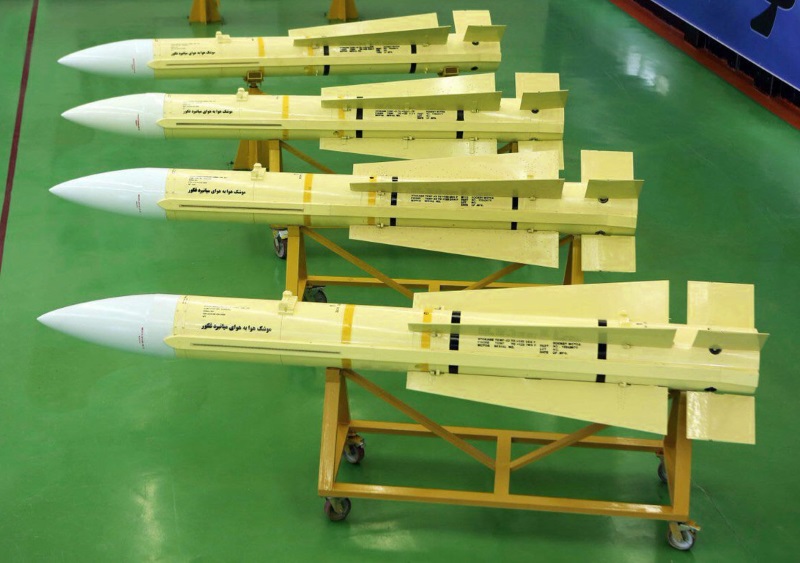
The Iranian stockpile of Phoenix AAMs eventually went to ruin from use and age. The Iranians built the US MIM-23 Hawk surface-to-air missile, and so rigged it up as an AAM to use the F-14's fire-control system, a Tomcat carrying three of them, designated "AIM-23". That was a painfully clumsy scheme, so the Iranians simply cloned the Phoenix airframe, then crammed the Hawk seeker and rocket motor into it -- the Hawk and Phoenix are roughly the same size. The resulting "AIM-23B Fakkur-90" looked just like a Phoenix, except for ducts running up each side; an Iranian Tomcat could, of course, carry six of them. It appears to be in service now, but numbers built so far are unclear.
As a footnote, the US Navy considered a surface-to-air missile (SAM) version of the Phoenix, as a medium-range defense for carrier groups. While Tomcats launched from aircraft carriers were intended to provide an outer layer of protection, the Sea Phoenix would have been installed on the carriers themselves, providing a closer, but still long-range defensive ring against any aircraft or missiles that may have made it through.
The plan was to install three launchers on a carrier to provide full 360-degree coverage for each ship. Each of those systems would have been a standalone item, combining a fixed 12-cell launcher for Phoenix missiles, an AWG-9 radar, plus the various controls and displays required to operate it. The scheme never came close to being implemented.
BACK_TO_TOP* The original Falcon series of AAMs was ultimately replaced by another line of AAM development. In 1947, an engineer named William Burdette McLean at the Naval Ordnance Test Station at China Lake in California began tinkering with heat-seeking AAM concepts. Navy brass weren't excited about that idea, preferring radar guidance since it could be used in any weather, and were pressing forward with what would eventually emerge as the Sparrow AAM.
McLean worked on his concepts, while keeping a low profile. In 1951, his team put on a demonstration for Admiral William S. "Deak" Parsons, deputy chief of the Bureau Of Ordnance, with Parsons ordering it into development. The weapon was named the "Sidewinder" by the NOTS team, in honor of the horned desert rattlesnake that hunted its prey by sensing heat.
Flight tests and firings followed -- one of the test pilots being Walter A. "Wally" Schirra, who would become one of the famous Mercury 7 astronauts. By late 1953, the Sidewinder was flying right, Navy brass becoming enthusiastic about the program. McLean moved on to an upper management position at NOTS in 1954, with his place as project head taken by his subordinate Howard Wilcox. The Air Force had been disinterested, but Wilcox was persistent, and managed to arrange a "shootout" between the Sidewinder and Falcon AAMs in 1955. The simpler and cheaper Sidewinder proved highly effective, and the Air Force came on board the program.
* The Sidewinder went into formal service at the beginning of 1956. The initial version was the "AIM-9B". It featured a solid-fuel rocket motor, and a blast-fragmentation warhead detonated by an infrared proximity fuze. It had four triangular forward control fins and four larger tailfins. Hot exhaust gas was used to drive the forward control fins.
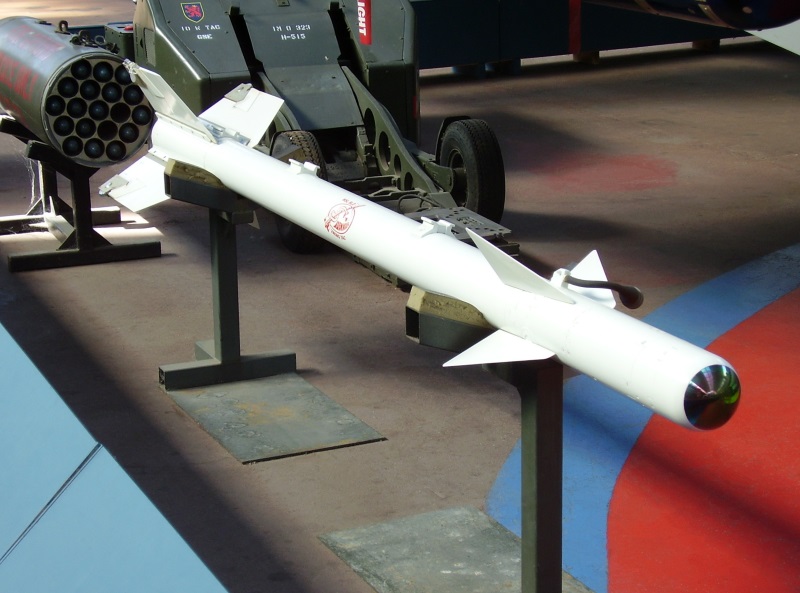
The AIM-9B used a reticle seeker, with an angled mirror rotating in step with the reticle to provide a cone-shaped scan. The control electronics guided the missile to stay in the center of the scan -- which meant better accuracy, and a wider field of view than would have been true without the scanning mirror. The aircraft interface for the AIM-9B was as simple as the rest of the weapon, with an audio tone fed into the pilot's headphones that went from a low growl to a shrill whine as a target "lock" was acquired. The seeker could only pick up particularly hot targets, meaning it had to be focused on an aircraft's exhaust. The AIM-9B was also not very maneuverable and fairly easy to shake.
One very interesting feature of the AIM-9B was that the tailfins featured little control surfaces at their upper corners for roll stability. They were called "rollerons", and were based on a clever scheme. Each rolleron had a little wind-driven spinning wheel on top. Before launch, the rolleron surfaces were clipped into place from the rear, with the sharp launch acceleration knocking off the clips. The wheels quickly spun up; if the missile started to roll, the angular momentum of the wheels would cause the rolleron surfaces to turn in a direction to cancel the roll.
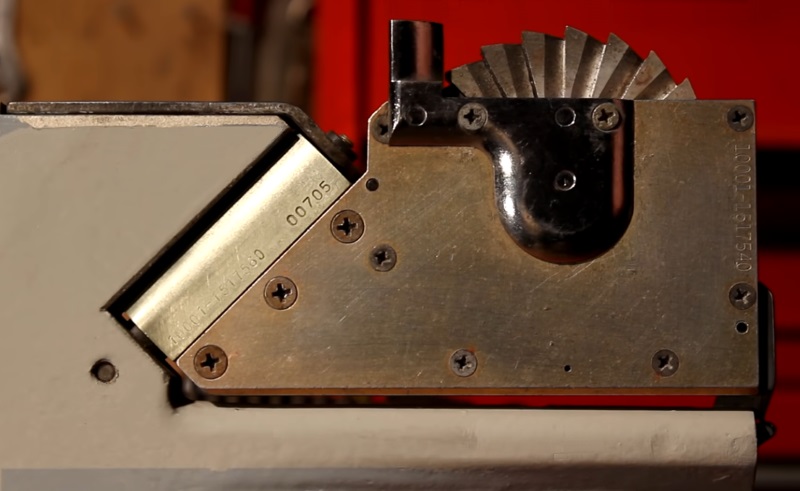
Both the US Navy and Air Force acquired the AIM-9B, with about 40,000 built. It was also obtained by NATO air arms, being produced by the FGW company in Germany, which built a substantially improved version designated the "AIM-9B FGW Mod 2". It featured more modern components, including solid-state electronics instead of vacuum tubes, and also had an improved seeker using CO2 gas for cooling. The Swedes license-built the AIM-9B as the "Robot 24B (Rb 24B)", for use on the SAAB Draken and Viggen fighters.
First combat use of the Sidewinder was in 1958, when Nationalist Chinese F-86 Sabres armed with Sidewinders tangled with Communist Chinese MiGs, with the Taiwanese claiming four kills. One MiG was later hit with a dud Sidewinder and took it back home, with the weapon being carefully duplicated by Soviet engineers, to result in the "Vympel K-13". It was built in limited quantities as a stopgap, being quickly improved to the more satisfactory "K-13A", which did go into widespread service. NATO assigned it the reporting name of "AA-2A Atoll".
The AIM-9B saw plenty of combat in Vietnam, but it wasn't a miracle weapon. The seeker system was easily confounded by sunlight and other sources of heat, with pilots saying they could hear a continuous fluctuating growl in their headphones. Reliability wasn't good enough, nor was range and maneuverability. However, dozens of kills were claimed with the AIM-9B, and it provided a basis for improved Sidewinder variants.
BACK_TO_TOP* The AIM-9B's limitations led to a drive to improve the type, resulting in the US Navy "AIM-9D", which featured:
The AIM-9D was followed by the slightly improved "AIM-9G", which featured a further improved seeker that could be slaved to a fighter's radar. Most US Navy Sidewinder kills in Vietnam were performed with the AIM-9D/G. The still better Navy "AIM-9H" was introduced in 1972, the last year of the war for the US; it featured all solid-state electronics and more maneuverability. The Soviets improved their K-13 AAM to create a general equivalent of the AIM-9G, designated the "K-13M", with the NATO reporting designation of "AA-2C Advanced Atoll".
* The Air Force was slower to develop improved Sidewinder variants, partly because the service was distracted by work on alternatives, particularly the dubious Falcon series. However, the USAF still needed to fix the problems with the AIM-9B, coming up with the "AIM-9E" in the late 1960s. The AIM-9E featured an infrared seeker with thermoelectric cooling, eliminating the need for cooling gas; an improved optical system in a streamlined warhead; and simpler wiring. Mitsubishi of Japan built a derivative of the AIM-9E, designated the "AAM-1".
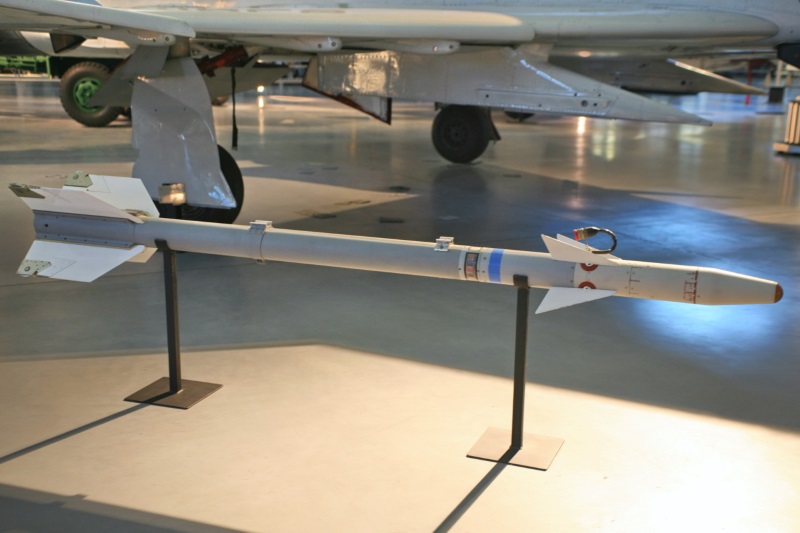
The AIM-9E was followed in 1972 by the "AIM-9J", which was an AIM-9E with new, distinctive "double-sweep" control fins to provide greater maneuverability -- giving the missile a more "arrowhead" look -- plus tweaks such as addition of some solid-state components, and a better control actuator system. A still further improved "AIM-9N" was introduced a year later, featuring an improved electronics subsystem; it was otherwise much the same as the AIM-9J. While the US supplied Sidewinders to most of its allies, some allies were more trustworthy than others, and so less sophisticated "AIM-9P2" and "AIM-9P3" variants were introduced. The Swedes built the AIM-9P3 as the "Robot 24J (Rb 24J)", for the Draken and Viggen.
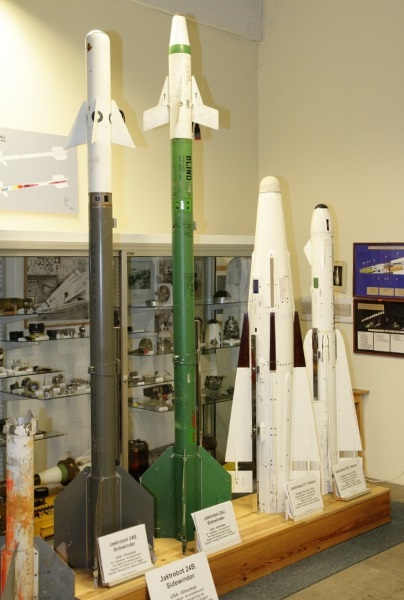
* The various second-generation Sidewinders -- AIM-9D, AIM-9E, and their refinements -- were only built in relatively small quantities, often as upgrades of older Sidewinders. The fact of the matter was that the technology was advancing rapidly at the time, and each of these variants was quickly replaced by something better.

The tinkerings with the second-generation Sidewinders led to the "AIM-9L", the first of the "all-aspect" Sidewinders: it was essentially an AIM-9H with a much more sensitive seeker based on indium antimonide (InSb) and cooled by argon gas, which allowed it to pick out a target from any angle ("aspect"), eliminating the need for obtaining an exhaust lock. The gas can was stored in the missile itself, meaning no need to insert a can into the launch rail, with enough gas to keep the seeker continuously cooled during the combat phase of a mission.
The AIM-9L also featured a new pattern of double-delta control fins and an improved warhead, with a double-layer continuous-rod scheme that caused the rods to tumble, and a laser proximity fuze system -- featuring a ring of solid-state lasers around the missile, each emitting a pulse pattern, with an associated photodiode picking up the pulse reflections from the target at close range. The AIM-9L was introduced in the early 1980s, with the British putting it to use in the Falklands War, and the Israelis employing it against the Syrians over Lebanon. It was the weapon that the Sidewinder had long promised to be, providing an almost sure kill.

The AIM-9L could still be spoofed by countermeasures, and so it was quickly followed by the "AIM-9M", with a seeker featuring better countermeasures rejection, and a low-smoke motor to make it harder to see coming. Many were later updated to "AIM-9M-9" standard, with an improved ability to tell sophisticated flares from engine exhausts.
___________________________________________________________________
AIM-9M SIDEWINDER:
___________________________________________________________________
wingspan:
63 centimeters (25 inches)
length:
2.83 meters (9 feet 3 inches)
diameter:
12.7 centimeters (5 inches)
total weight:
85.2 kilograms (188 pounds)
warhead weight:
9.36 kilograms (20.8 pounds)
speed:
Mach 2+
range:
> 10 kilometers (> 6.2 MI / 5.4 NMI)
___________________________________________________________________
Export equivalents included the "AIM-9P4" and "AIM-9P5". The Swedes used the AIM-9P5 as the "Rb 74", sometimes called the "Rb 24L", with the weapon carried on the Draken and Viggen fighters. It is unclear if the Rb 74s were built in Sweden, or obtained from the USA. In addition, Mitsubishi developed a derivative of their AAM-1 with an all-aspect seeker, designated the "AAM-2", but it was never produced.
BACK_TO_TOP* There were some unusual offshoots to the Sidewinder family, one of the earliest being the "AIM-9C". It was the only Sidewinder AAM to give up on heat-seeking and use SARH. It was only flown on the Navy's Vought F-8 Crusader, which couldn't carry the bigger Sparrow. Several hundred AIM-9Cs were later converted into an anti-radar missile (ARM) for the US Marines, designated the "AGM-122A" and known as the "Sidewinder ARM" or "SideARM". The Soviets similarly developed a SARH version of their K-13M AAM, designated the "K-13R", with the NATO reporting name of "AA-2D Advanced Atoll".
In a somewhat related exercise, in 2012 the German Diehl firm announced a "Laser-Guided Sidewinder (LAGS)", which was just a stock AIM-9L fitted with a laser seeker instead of a heat seeker -- the idea being to use the weapon as a light air-to-ground missile, leveraging off large existing stocks of the AIM-9L. It doesn't appear it was ever fielded.
The Sidewinder saw extensive service as a surface-to-air missile (SAM), the US Army adopting it for launch with the "M48 Chaparral" launcher system, which went into service in 1969. The vehicle was based on the ubiquitous tracked M113 armored personnel carrier; it had a rotating turret, with a gunner in the center, who targeted with "Mark 1 Eyeball". "M48" was the designation of the entire system; the tracked vehicle was the "M730", and the turret was the "M54". Later, an infrared imager was added to the system to give some night / all-weather capability. The turret could handle four Sidewinders, with the vehicle carrying up to eight reloads.
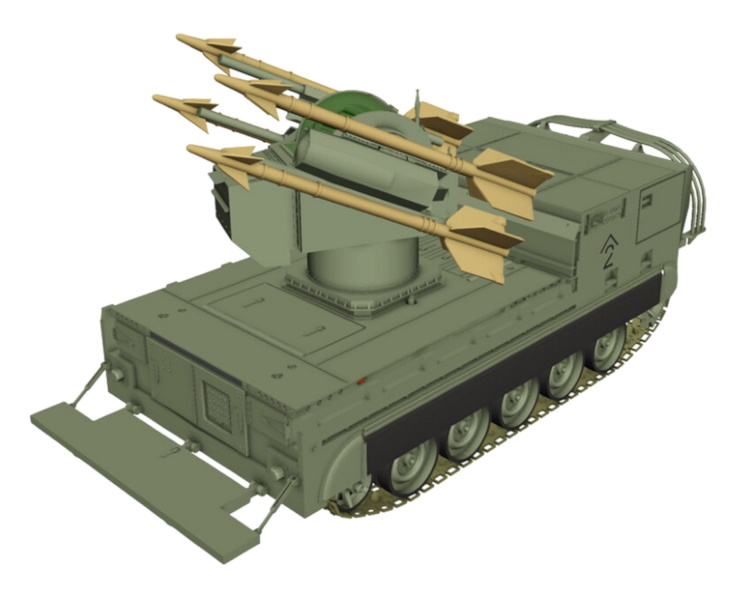
The original Sidewinder carried on the Chaparral, the "MIM-72A", was based on the AIM-9D, the only major difference being that it only had rollerons on two of the fins, not all four. There was a training version, the "MIM-72B". Subsequent versions of the missile followed a development path separate from that of the air-launched variants:
The Chaparral was seen at the outset of being of limited utility, though it became more useful with updates. It was exported to Egypt, Israel, Morocco, Taiwan, and Tunisia. The US military phased it out in 1997, the weapon having been replaced by the Stinger. It apparently lingers in service elsewhere.
Following the Russian invasion of Ukraine in 2022, Ukraine received a motley assortment of hand-me-down SAMs and AAMs from its allies. The various missiles were often mated to a variety of surface-launch platforms for which they had never been intended, the resulting systems being called "FrankenSAMs". The AIM-9M was among the missiles provided, with the Ukrainians making good use of it as a SAM -- notably firing two of them from a drone boat to shoot down two Russian jet fighters in 2025.
* Another interesting footnote to the Sidewinder story was the US Navy's "RIM-116 Rolling Airframe Missile (RAM)", a heavily modified ship-launched Sidewinder, intended as a defense against antiship missiles. As introduced, it had a radar-homing seeker to zero in on an antiship missile's radar seeker, using infrared guidance for terminal attack.
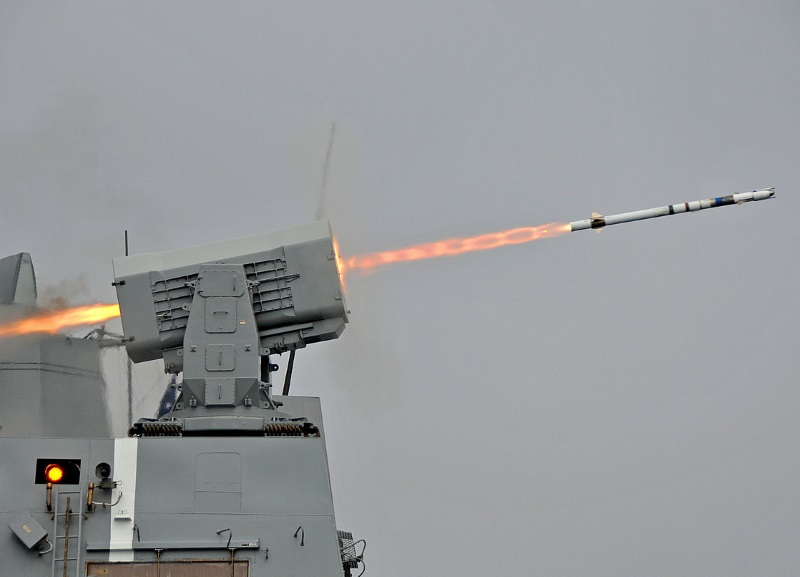
Unlike an air-launched Sidewinder, the RAM was spin-stabilized, hence the name; antiship missiles traditionally aren't very maneuverable, so the RAM didn't need to be very maneuverable either. It correspondingly had smaller fins than an air-launched Sidewinder. RAM was introduced to service in 1992.
___________________________________________________________________
RIM-116 ROLLING AIRFRAME MISSILE:
___________________________________________________________________
wingspan:
43 centimeters (17 inches)
length:
2.79 meters (9 feet 2 inches)
diameter:
12.7 centimeters (5 inches)
total weight:
73.5 kilograms (162 pounds)
warhead weight:
11.3 kilograms (25 pounds)
speed:
Mach 2+
range:
9 kilometers (5.6 MI / 4.9 NMI)
___________________________________________________________________
RAM was obtained not only by the US Navy, but the navies of Germany, Greece, South Korea, Egypt, Turkey, and the United Arab Emirates. The "Block 1" RAM added the ability to use the infrared seeker for targeting from launch, to handle missiles that weren't using radar seekers. A "Block 2" RAM followed, featuring a larger rocket motor for extended range; new flight control surface actuation system for enhanced maneuverability; new digital autopilot; enhanced passive radar seeker; and other refinements. It went into service in 2015. RAM remains in widespread service, and presumably will obtain further updates.
BACK_TO_TOP* The US military fell behind the Soviet Union during the 1980s in the development of "off-boresight" dogfighting missiles, where the pilot simply turns his or her head to fix a helmet-mounted sight on an enemy, firing the missile after a lock was acknowledged, and the missile maneuvering to follow the lock. To counter the Soviets, during the 1980s Britain and Germany planned to develop a Sidewinder follow-on, to be designated the "AIM-132 Advanced Short-Range AAM (ASRAAM)" -- which the Americans would then adopt.
By the end of the decade, the USSR was falling apart, with defense requirements being re-assessed, with the British and Germans parting company. The British would eventually field ASRAAM, while the Germans would field their own Sidewinder follow-on, the "Infra Red Imaging System / Thrust Vector-Controlled (IRIS-T)" missile.
The breakup of the program led the US to work on their own improved Sidewinder. In 1996 the US Department of Defense conducted a competition for such a weapon, under the designation "AIM-9X". Hughes won the award with their "Evolved Sidewinder" design. It used the AIM-9M Sidewinder fragmentation warhead, proximity fuze, and solid fuel motor. However, the size of all the airfoils was reduced, with four vanes in the rocket exhaust to support thrust-vectoring. It finally got rid of the rollerons; they weren't consistent with an agile weapon, and the flight control system was smart enough not to need them.
Most significantly, it used a new seeker head, derived from the seeker developed for ASRAAM. The seeker had an imaging infrared array, fed by a gimbaled telescope through a prism system, with cooling provided by a Stirling-cycle cryocooler. The AIM-9X had an "off-boresight" capability, meaning it could be cued by a helmet-mounted sight to lock onto targets not directly in front of it.

The program ran into delays and the missile didn't enter service until 2003. It was widely adopted, becoming a standard weapon of the US military, and America's allies. Raytheon, which acquired the program, developed a "Block II" AIM-9X, featuring a new fuze; a one-way datalink for midcourse corrections, and derived from the datalink for the AIM-120 AMRAAM missile, discussed later; and an associated "lock-on after launch (LOAL)" capability. In effect, the datalink allowed the missile to be fired at extended range and directed under "command control" until it got close enough to the target to establish a lock, then performed a terminal attack.
The Block II was introduced in 2015, being followed by a "Block II+" in 2017, apparently featuring a "stealthy" anti-radar coating. It was to be followed by a "Block III", which would have had a new rocket motor to give it "beyond visual range", plus a new "insensitive" warhead that would be safer to handle. The Block III was canceled due to budget cuts, but the new warhead was retrofitted to the Block II. It appears work on a new rocket motor has continued.
Further development has been done on improved software to allow the AIM-9X to be used against surface targets, with the missile destroying a mobile armored personnel carrier and a moving target boat in tests. Work has also been done on a SAM version of the AIM-9X, with test launches performed from a Humvee (High-Mobility Multipurpose Wheeled Vehicle / HMMWV) four-wheel combat vehicle. It has also been fired from the "Multi-Mission Launcher (MML)", which is a 15-tube missile launcher that can be mounted on a tactical truck. The MML can accommodate a range of different missiles, not just the AIM-9X, the missiles being handled in standardized shipping / launch containers, and can be hooked into different tactical air-defense systems.

The MML is an experimental program at this time, with no mention of if or when it will be fielded. Sources also mention that the AIM-9X has been fired underwater from submarines, using a capsule launch system -- though details are lacking. Mitsubishi of Japan, incidentally, developed an equivalent to the AIM-9X as the "AAM-5" -- but the two weapons were only similar in general specification.
BACK_TO_TOP